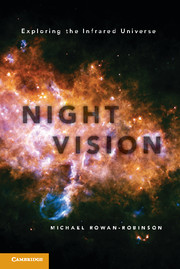Book contents
- Frontmatter
- Contents
- Preface
- 1 Introduction
- 2 William Herschel Opens Up the Invisible Universe
- 3 1800–1950
- 4 Dying Stars Shrouded in Dust and Stars Being Born
- 5 Birth of Submillimetre Astronomy
- 6 The Cosmic Microwave Background, Echo of the Big Bang
- 7 The Infrared Astronomical Satellite and the Opening Up of Extragalactic Infrared Astronomy
- 8 The Cosmic Background Explorer and the Ripples, the Wilkinson Microwave Anisotropy Probe and Dark Energy
- 9 Giant Ground-Based Near-Infrared and Submillimetre Telescopes
- 10 The Infrared Space Observatory and the Spitzer Space Telescope
- 11 Our Solar System’s Dusty Debris Disk and the Search for Exoplanets
- 12 The Future
- Epilogue
- Notes
- Credits for Illustrations
- Glossary
- Further Reading
- Bibliography
- Name Index
- Subject Index
3 - 1800–1950
Slow Progress – the Moon, Planets, Bright Stars and the Discovery of Interstellar Dust
Published online by Cambridge University Press: 05 March 2013
- Frontmatter
- Contents
- Preface
- 1 Introduction
- 2 William Herschel Opens Up the Invisible Universe
- 3 1800–1950
- 4 Dying Stars Shrouded in Dust and Stars Being Born
- 5 Birth of Submillimetre Astronomy
- 6 The Cosmic Microwave Background, Echo of the Big Bang
- 7 The Infrared Astronomical Satellite and the Opening Up of Extragalactic Infrared Astronomy
- 8 The Cosmic Background Explorer and the Ripples, the Wilkinson Microwave Anisotropy Probe and Dark Energy
- 9 Giant Ground-Based Near-Infrared and Submillimetre Telescopes
- 10 The Infrared Space Observatory and the Spitzer Space Telescope
- 11 Our Solar System’s Dusty Debris Disk and the Search for Exoplanets
- 12 The Future
- Epilogue
- Notes
- Credits for Illustrations
- Glossary
- Further Reading
- Bibliography
- Name Index
- Subject Index
Summary
One of the reasons Herschel and his discovery of infrared light do not resonate more strongly in the history of science is that it took so long for infrared astronomy to develop. During the 150 years after Herschel, from 1800 to 1950, progress was extremely slow. There were two main reasons for this slow progress. Firstly, the night is not ‘dark’ at infrared wavelengths; in fact it is very bright. The Earth’s atmosphere radiates strongly in the infrared as part of the greenhouse process, so even if we had infrared eyes we would have great difficulty picking out the stars against this bright foreground, even at night. The second and main problem was the slow progress in developing infrared detectors. Herschel’s thermometers could detect infrared radiation from the Sun, but to detect anything else something better was needed. In this chapter I describe the slow progress in detector technology through the nineteenth and early twentieth centuries, the detection of infrared radiation from the Moon during the classic expedition of Piazzi Smyth to Tenerife, the efforts between 1870 and 1914 to detect radiation from bright stars, and the crucial discovery in the 1930s of extinction of visible light by interstellar dust.
The first step on the road to improved infrared detectors was made by a German physicist, Thomas Seebeck (1770–1831). In 1821, he made a discovery that led to the invention of the thermocouple. He found that when a metallic strip is constructed of two different metals and then heated, a small electric current is generated in the strip. The thermocouple applies this discovery to the detection of heat, or infrared radiation, by measuring the current generated from a bimetallic strip when heated. It was this device, far more sensitive than the thermometer used by Herschel, that Piazzi Smyth would use to make the next major discovery in infrared astronomy, the detection of infrared radiation from the Moon, the second brightest astronomical object in the sky.
- Type
- Chapter
- Information
- Night VisionExploring the Infrared Universe, pp. 23 - 34Publisher: Cambridge University PressPrint publication year: 2013
- 2
- Cited by



